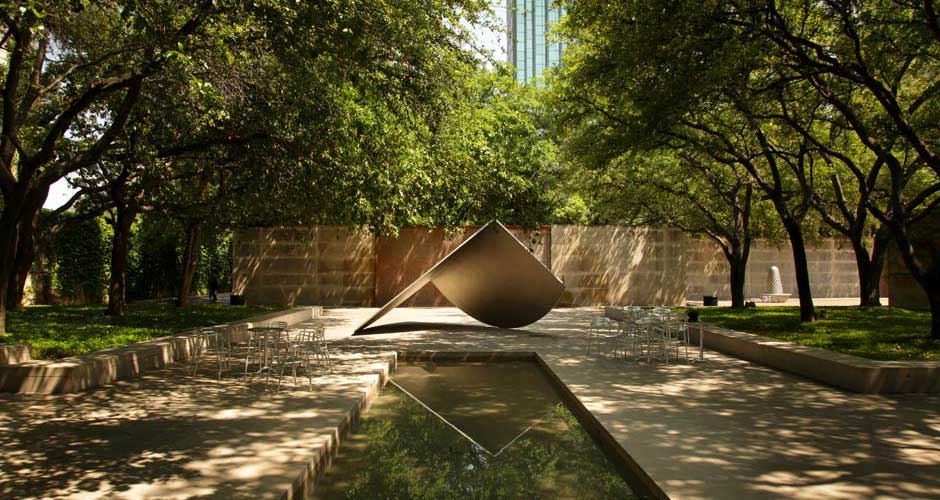-
In the 1970s Dallas initiated plans to create a centralized downtown arts district, which would consolidate the city’s art and cultural institutions and help revitalize the downtown core. The 68-acre Dallas Arts District, located adjacent to the city’s business district, was laid out by the landscape architecture firm of Sasaki Associates.
.jpg) Modernist architect Edward Larrabee Barnes was hired to create a world-class museum that could hold the city’s growing art collection. Collaborating with Dan Kiley as landscape architect for the project, his design for the Dallas Museum of Art, which opened in 1984, would take the form of a simple rectilinear building with a barrel vaulted roof, faced with Indiana limestone. Kiley-Walker was hired to create planting plans for the space, including the streetscape and museum entry court, interior courtyards, an adjacent parking area and the outdoor sculpture garden. Kiley wrote of the project: “For us, setting a stage for art was as crucial as the pieces themselves.”
Modernist architect Edward Larrabee Barnes was hired to create a world-class museum that could hold the city’s growing art collection. Collaborating with Dan Kiley as landscape architect for the project, his design for the Dallas Museum of Art, which opened in 1984, would take the form of a simple rectilinear building with a barrel vaulted roof, faced with Indiana limestone. Kiley-Walker was hired to create planting plans for the space, including the streetscape and museum entry court, interior courtyards, an adjacent parking area and the outdoor sculpture garden. Kiley wrote of the project: “For us, setting a stage for art was as crucial as the pieces themselves.”
Upon approaching the museum, Kiley’s hand can be seen immediately in the design for the property’s perimeter. As in many of his designs, Kiley’s landscape creates a dialogue with the architecture. His simple palette uses lawn, water, trees and ivy to enliven the building’s restrained limestone façade. Rows of trees provide an edge between the building and adjacent roadway. A square recessed courtyard provides a formal entry to the building. Kiley’s entry design is both simple and elegant – a circular fountain at its center and four live oak trees in square beds, one at each corner of the court.
.jpg) Upon entering the museum, visitors gain access to three interior courtyards: the Tribal Court, Dining Court and Wisteria Court. Kiley’s simple designs for these spaces create quiet places for contemplation. Adjacent to the museum building, Barnes designed an outdoor sculpture garden that he enclosed with an 8-foot high limestone wall. The entry to the Sculpture Court from the museum is defined by a long 9-foot x 37-foot rectangular pool of water, at the head of which sits a sculpture by Ellsworth Kelly. Four planting beds edge this space, which opens out onto a larger square courtyard, broken up into six individual garden rooms by three ten-foot high water walls designed by Alistair Bevington, an architect with Barnes’ firm. At the base of each wall is a narrow rill, which serves as a catchment basin. Each rill is L-shaped creating a further division between the rooms while allowing for sheltered views that draw visitors through the site. Stepped pyramidal planting beds contain groundcover of Asian jasmine and vinca, set beneath bosques of live oak trees. English ivy is planted to creep up the limestone walls, while seasonal bulb displays add a playfulness to the garden. Moveable seating allows the space to be used for larger events and provides a resting place for tired museum visitors.
Upon entering the museum, visitors gain access to three interior courtyards: the Tribal Court, Dining Court and Wisteria Court. Kiley’s simple designs for these spaces create quiet places for contemplation. Adjacent to the museum building, Barnes designed an outdoor sculpture garden that he enclosed with an 8-foot high limestone wall. The entry to the Sculpture Court from the museum is defined by a long 9-foot x 37-foot rectangular pool of water, at the head of which sits a sculpture by Ellsworth Kelly. Four planting beds edge this space, which opens out onto a larger square courtyard, broken up into six individual garden rooms by three ten-foot high water walls designed by Alistair Bevington, an architect with Barnes’ firm. At the base of each wall is a narrow rill, which serves as a catchment basin. Each rill is L-shaped creating a further division between the rooms while allowing for sheltered views that draw visitors through the site. Stepped pyramidal planting beds contain groundcover of Asian jasmine and vinca, set beneath bosques of live oak trees. English ivy is planted to creep up the limestone walls, while seasonal bulb displays add a playfulness to the garden. Moveable seating allows the space to be used for larger events and provides a resting place for tired museum visitors.
1 Kiley, Dan and Jane Amidon, Dan Kiley: The Complete Works of America’s Master Landscape Architect (Boston, New York, London: Little, Brown and Company, 1999), 94.
-
Gary Hilderbrand, FASLA, 2013
Edward Larrabee Barnes’ 1983 Dallas Museum of Art contains something like nine public entrances—an organizational chaos that goes against conventions for museum access and security. Barnes made sense of all these perforations by attaching them all to a single broad corridor, the Concourse, which brings clarity to the building’s north/south organization. By contrast, the routes through the Museum’s display spaces lack this straightforwardness. While the collections are truly distinguished, travel through the galleries can be indirect, meandering, and even confusing.
Movement through the Sculpture Garden is also purposefully indirect. Designed by Kiley with architect Alistair Bevington from the Barnes office, a massive concrete wall conceals the garden’s presence on Ross Avenue. A single open-grate steel gate provides a straight-on view of ten vertical feet of rushing water inside the garden. Upon entry, the water wall occludes your destination: Neither left nor right offers a clear itinerary. To find the museum entrance, you will meander through courts, channels, sculptures, and groves of Live Oak trees.
The DMA’s garden remains for me one of the great examples of a well-known modernist conceit: the desire to translate the balanced calm of an abstracted non-directional field into a compelling three-dimensional spatial realm. Transforming these ideals from painting to landscape space often results in tiresome disorder and ambiguity, but when it works, it’s hugely satisfying. In a scheme like this, the devices that shape movement and seeing are not deterministic, not directed, not linear; light and shadow and sound guide your experience. It’s like wandering through one of Paul Klee’s deftly warped grids—the kind overlain with color and pattern of varying intensities. At the DMA, it works beautifully, partly because the precise channel of water threading through the middle of the scheme gives you a momentary glimpse of the whole without revealing everything. And Kiley’s bunches of Live Oaks remind me of the native Oak colonies all over eastern Texas; the trees grow improbably close together, their branches merging into a continuous dark mass of evergreen canopy. Repeated in three triangular and four rectangular grids against the backdrop of Bevington’s tall walls, Kiley’s trees have evolved a landscape character that cools the body, charges the memory, and propels you, ever slowly, to the ninth set of doors. Another kind of art lies beyond.
-
Landscape Voice. “Dallas Museum of Art Garden,” http://landscapevoice.com/dallas-museum-of-art-garden/.
The Dallas Arts District. “Architecture: Dallas Museum of Art,” http://www.thedallasartsdistrict.org/district/art-in-architecture/architecture.
The Cultural Landscape Foundation. “What’s Out There: Dallas Museum of Art,” http://tclf.org/landscapes/dallas-museum-art.
Kiley, Dan and Jane Amidon. Dan Kiley: The Complete Works of America’s Master Landscape Architect (Boston, New York, London: Little, Brown and Company, 1999), 94-97.
“Dan Kiley: Landscape Design II.” Process: Architecture 108. (Tokyo: Japan, Process Architecture Publishing Co., 1993), 91-93.








.jpg)
.jpg)





